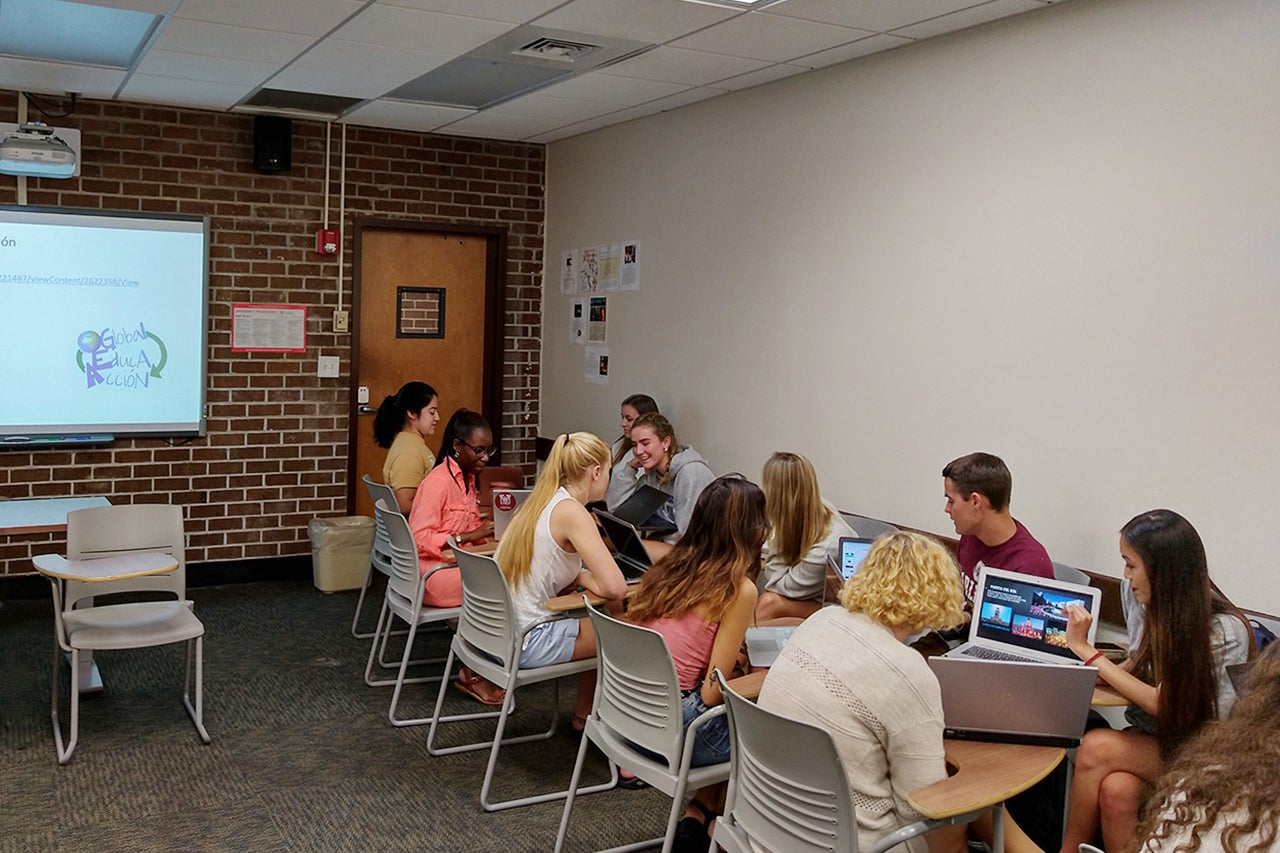Well before the COVID-19 pandemic moved more classes online and restricted travel, the Global Leadership Institute (GLI) in the College of Charleston’s School of Languages, Cultures, and World Affairs (LCWA) embarked on a plan to leverage digital technology in order to integrate immersive and sustained international education into the daily classroom experience.
Each year select courses from LCWA are designated as “Globally Connected.” These courses emphasize experiential international learning through the regular course of study via virtual exchanges and digital peer-to-peer projects with students and international partners from around the world. And that means global education does not have to stop, even when international travel does.
“We aim for GLI to be the nexus where academic disciplines merge, the realities of the world are confronted, and where knowledgeable, engaged citizens of the world come of age,” says Tim Johnson, dean of the School of Languages, Cultures, and World Affairs.
The GLI piloted five globally connected courses over the fall 2019 and spring 2020 semesters.

Antonio Pérez-Núñez, assistant professor of Spanish, used FlipGrid to host online activities between his students at CofC and students in Málaga, Spain, during the fall 2019 semester.
“We created these courses to help students develop knowledge, skills and aptitudes that they can use at home and abroad in intercultural interactions,” says Antonio Pérez-Núñez, assistant professor of Spanish. “It’s uncharted territory; there are no textbook guidelines. Our key to success is finding a partner who is on board and willing to collaborate with you and their students abroad.”
Stephen Della Lana, senior instructor of German, took the opportunity to reengage with his former student Kristen Gehrman ’09, for his German in international business course. Based in the Netherlands, Gehrman translates literary works and teaches an English proofreading class for undergraduates at the VU Amsterdam (Vrije Universitiet).
“Having the CofC connection abroad made the program even more fun,” says Della Lana, who traveled to Amsterdam to meet with Gehrman and work out projects that would resonate with students on both sides of the Atlantic. “We came up with three projects for our students to work on together. All students had tandem partners with whom they did proofreading tasks over Skype sessions. They were given clear expectations on their collaborative efforts. For many, the collaboration served as the highlight of the course, along with our guest speakers who work in the field.”
The results of the globally connected courses exceeded expectations. A total 11 such courses are being offered for the fall 2020 semester, ranging from Arabic to the history of Israel to international management to folklore of the African Diaspora.
Each course incorporates the following elements:
- Engagement with persons, especially peers, of one or more target cultures in dialog and/or activities, which include collaborative on-line international learning.
- Participatory activities to develop an understanding and respect for other cultural perspectives and/or points of view.
- Development of targeted knowledge, skills and attitudes that lead to behavior and communication that are both effective and appropriate in intercultural interactions.

Jessica Charlton, right, became friends with her Nicholle, left, through her globally connected course on foreign education. (Photos provided)
For Jessica Charlton ’20, the globally connected course on foreign language education taught by Silvia Rodriguez Sabater, associate professor of Hispanic studies, proved to be transformative.
“I have been learning Spanish since high school,” says Charlton, who double majored in foreign language education and Spanish. “I have spent time abroad and made strong bonds with locals with whom I still speak. Professor Sabater’s class, however, was my first time meeting someone from a different culture on the same track in life as me. My course partner, Nicholle, from Chile, is now starting her first year teaching English, as I begin my career as a certified professional teaching Spanish.”
Charlton continues to chat regularly with Nicholle as they are now fast friends.
“The most meaningful thing I gained from Dr. Sabater’s course was a clear understanding that regardless of age, languages spoken, cultural differences or location, we are all one and the same,” she says. “The more I have spoken with Nicholle, the more I realize how small our world is and how oftentimes society gives us the idea that just because you come from different places or you may look different that you can’t have things in common or find common ground.”
As a Spanish teacher at Goose Creek High School in Berkeley County, South Carolina, Charlton is using these experiences to help her students become proficient in Spanish so that they may be able to use and apply the language in a real-life setting, like the partner conversations Sabater set up for her students.
“I strive to impart upon my students the truth that learning and knowing other languages and cultures builds a bridge to other ways of life and people that you otherwise may have never met,” says Charlton. “I think my job as a world language educator is all about teaching my students that the world is interconnected and that ‘our way’ is not the only way to live. ‘Different’ should be the gold standard.”
Featured image: In the fall of 2019 Students in FYE 120: Spanish Panorama, a globally-connected course, did an online intercultural exchange with students from Spain, discussing topics such as food, lifestyle, education and technology, through videos they created on FlipGrid.




